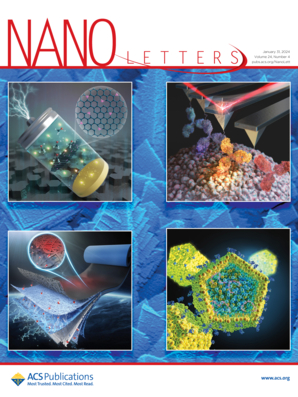时域滤波太赫兹纳米镜观察光与物质的内在相互作用
IF 9.6
1区 材料科学
Q1 CHEMISTRY, MULTIDISCIPLINARY
引用次数: 0
摘要
太赫兹(THz)技术在生物传感和信息通信等各种应用领域具有巨大潜力,但传统的远场技术受到衍射的限制。近场光学显微镜克服了这一障碍,其锋利的尖端可将入射太赫兹波集中到纳米体积内,通过检测近场散射来揭示纳米级光学特性。然而,由于太赫兹波长较大,尖端和悬臂上产生的共振表面波会掩盖内在响应。在这里,我们将近场显微技术与太赫兹时域光谱技术相结合,并利用拉长的悬臂进行时域滤波,以消除这一伪影,从而实现本征纳米光谱和纳米成像。通过应用这一技术,我们在纳米尺度上区分并表征了古代雕塑的历史颜料,如朱砂和红铅。我们还揭示了太赫兹光学天线中的深亚波长局部共振模式,展示了太赫兹纳米光子学的能力。我们的工作推动了太赫兹纳米成像和纳米光谱技术的发展,以探测纳米级太赫兹光与物质之间的内在相互作用。本文章由计算机程序翻译,如有差异,请以英文原文为准。

Time-Domain-Filtered Terahertz Nanoscopy of Intrinsic Light–Matter Interactions
Terahertz (THz) technology holds great potential across diverse applications, including biosensing and information communications, but conventional far-field techniques are limited by diffraction. Near-field optical microscopy overcomes this barrier through a sharp tip that concentrates incident THz waves into nanometric volumes, detecting scattered near-field to reveal nanoscale optical properties. However, owing to the large THz wavelengths, resonant surface waves arising on the tip and cantilever obscure the intrinsic response. Here we combine near-field microscopy with THz time-domain spectroscopy and implement time-domain filtering with an elongated cantilever to eliminate this artifact, achieving intrinsic nanospectroscopy and nanoimaging. By applying this technique, we distinguish and characterize historical pigments of an ancient sculpture, such as vermilion and red lead, on the nanoscale. We also unravel deep-subwavelength localized resonance modes in THz optical antennas, demonstrating capabilities for THz nanophotonics. Our work advances THz nanoimaging and nanospectroscopy techniques to probe intrinsic nanoscale THz light-matter interactions.
求助全文
通过发布文献求助,成功后即可免费获取论文全文。
去求助
来源期刊

Nano Letters
工程技术-材料科学:综合
CiteScore
16.80
自引率
2.80%
发文量
1182
审稿时长
1.4 months
期刊介绍:
Nano Letters serves as a dynamic platform for promptly disseminating original results in fundamental, applied, and emerging research across all facets of nanoscience and nanotechnology. A pivotal criterion for inclusion within Nano Letters is the convergence of at least two different areas or disciplines, ensuring a rich interdisciplinary scope. The journal is dedicated to fostering exploration in diverse areas, including:
- Experimental and theoretical findings on physical, chemical, and biological phenomena at the nanoscale
- Synthesis, characterization, and processing of organic, inorganic, polymer, and hybrid nanomaterials through physical, chemical, and biological methodologies
- Modeling and simulation of synthetic, assembly, and interaction processes
- Realization of integrated nanostructures and nano-engineered devices exhibiting advanced performance
- Applications of nanoscale materials in living and environmental systems
Nano Letters is committed to advancing and showcasing groundbreaking research that intersects various domains, fostering innovation and collaboration in the ever-evolving field of nanoscience and nanotechnology.
 求助内容:
求助内容: 应助结果提醒方式:
应助结果提醒方式:


